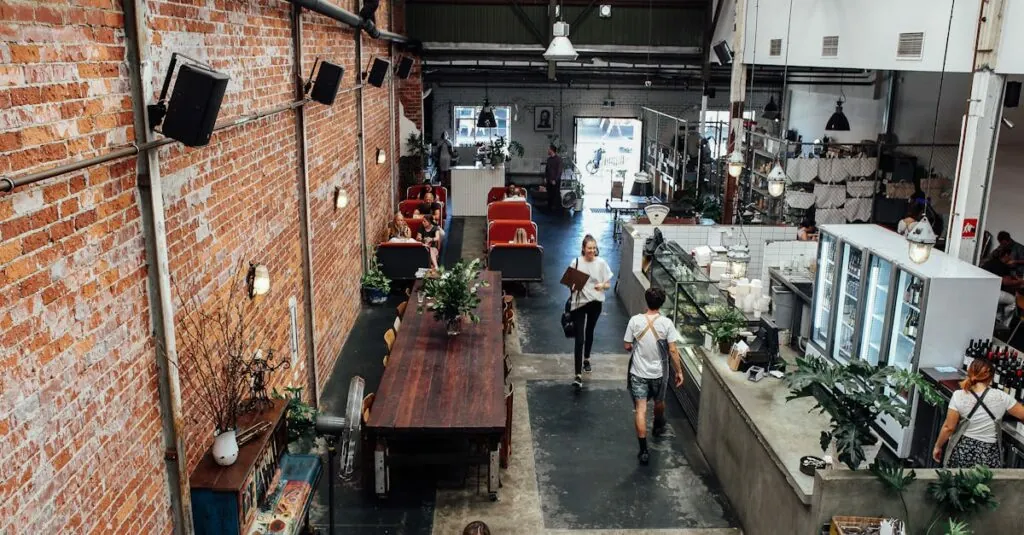Table of Contents
ToggleIn a world where food and drink trends change faster than a chef can say “Bon appétit,” staying ahead of the curve is no small feat. From plant-based delights to innovative brewing techniques, the food and beverage industry is buzzing with excitement. It’s like a culinary rollercoaster, and everyone wants a front-row seat.
As palates evolve and health-conscious choices take center stage, consumers are on the hunt for flavors that tantalize and nourish. Whether it’s sipping on the latest superfood smoothie or indulging in an artisanal snack, the trends shaping our plates are as dynamic as they are delicious. Buckle up as we dive into the latest trends that are not just tasty but also redefining how we think about our meals.
Overview of Latest Trends in Food and Beverage Industry
Plant-based foods continue to gain popularity, with consumers seeking more sustainable meal options. This shift reflects a broader movement towards health and environmental awareness. Advanced brewing techniques in beverages, such as nitro coffee and craft cocktails, showcase creativity and appeal to adventurous palates.
Flavorful ingredients play a crucial role, as artisans explore bold combinations that elevate traditional recipes. International flavors find their way into local cuisines, enhancing variety and enriching dining experiences.
The rise of functional foods also marks a significant development, as more people choose items that support wellness. Products boasting probiotics, superfoods, and adaptogens cater to health-focused individuals. Moreover, transparency in labeling resonates with consumers, prompting brands to disclose sourcing and production practices.
Sustainability practices have become essential in production processes, driving companies to adopt eco-friendly packaging and waste reduction methods. Organic certifications and local sourcing attract environmentally conscious customers.
Online ordering and delivery services have reshaped how individuals access food and beverages. Consumers appreciate the convenience of having meals delivered straight to their door. Innovative technologies, such as artificial intelligence and machine learning, enhance personalized dining experiences.
Finally, non-alcoholic alternatives are on the rise, as more individuals embrace mindful consumption. This trend includes sophisticated mocktails and craft beers, tailored to those seeking flavorful experiences without the alcohol.
Health and Wellness Focus
The food and beverage industry increasingly prioritizes health and wellness, with consumers seeking nutritious and satisfying options.
Plant-Based Options
Plant-based options continue to gain traction, driven by a growing awareness of health and environmental impacts. Brands now craft innovative meat alternatives, making tofu, legumes, and grains more accessible. According to recent data, sales of plant-based products surged by 27% in 2020, emphasizing consumer demand for these alternatives. Many restaurants also feature plant-based dishes on their menus, catering to diverse dietary preferences. This shift encourages chefs to experiment with flavors and textures, delivering exciting experiences for diners.
Functional Foods
Functional foods focus on health benefits beyond basic nutrition, appealing to a wellness-oriented audience. Probiotics, omega-3s, and superfoods dominate menus and grocery shelves, targeting gut health and immune support. Research shows that consumers are increasingly purchasing products labeled as functional, with a 22% rise in sales noted in the past year. Manufacturers respond by incorporating these ingredients into snacks, beverages, and meal options, offering a convenient way for individuals to enhance their diets. Transparency in labeling fosters trust, as consumers want to know how these foods contribute to their overall well-being.
Sustainable Practices
Sustainable practices shape today’s food and beverage industry, driving eco-conscious choices among consumers. Companies increasingly focus on innovative methods to minimize environmental impact.
Eco-Friendly Packaging
Eco-friendly packaging options dominate the market as brands seek to reduce their carbon footprints. Biodegradable materials, compostable plastics, and recycled products enhance sustainability efforts. Many consumers, approximately 74%, express a preference for brands that utilize sustainable packaging, encouraging companies to adapt. Packaging innovations like edible containers and refillable pouches also gain popularity, appealing to environmentally aware shoppers. Implementing these practices not only meets consumer demand but highlights the brand’s commitment to sustainability.
Local Sourcing
Local sourcing remains a key trend in creating sustainable food systems. Restaurants and food producers prioritize ingredients from nearby farms, reducing transportation emissions. This approach fosters community relationships and supports local economies. Data shows that 52% of consumers favor restaurants that offer locally sourced ingredients, prompting establishments to feature these items prominently on menus. Beyond supporting local producers, sourcing ingredients closer to home enhances freshness and flavor, providing an elevated dining experience that resonates with today’s health-conscious patrons.
Technological Innovations
Technological innovations significantly reshape the food and beverage industry, driving efficiency and enhancing customer experiences. Automation and artificial intelligence transform food production, improving quality and consistency across various processes.
Automation and AI in Food Production
Automation enhances food production by streamlining operations and reducing labor costs. Robots handle repetitive tasks, from packaging to cooking, ensuring a swift and efficient process. AI systems analyze data to predict consumer preferences, enabling manufacturers to create tailored products. Research shows that 75% of food businesses adopt AI to optimize supply chains and inventory management. Predictive analytics aids in managing stock levels based on demand trends, minimizing waste and improving profitability.
Online Ordering and Delivery Services
Online ordering and delivery services revolutionize how consumers access food. These services grow in popularity, with 60% of diners preferring to order takeout rather than dine in. Mobile apps make it easier for customers to browse menus and place orders directly from their devices. Delivery partnerships with major platforms expand reach for restaurants, allowing them to cater to a broader audience. Real-time tracking keeps customers informed about their order status, enhancing satisfaction levels. Increased reliance on these services highlights the industry’s shift toward convenience, making food access easier and more enjoyable than ever.
Experiential Dining
Experiential dining captivates consumers by merging culinary artistry with immersive environments. This approach creates memorable occasions centered around unique food experiences.
Unique Food Experiences
Consumers seek one-of-a-kind dining events and themed pop-ups that go beyond traditional meals. This trend promotes interaction between diners and chefs. Restaurants feature unique pairings, such as a Japanese whisky dinner, enhancing the dining adventure. Renowned chefs craft distinctive menus that highlight local ingredients, connecting customers with their regions. Culinary tours and tastings also engage food lovers, encouraging exploration of diverse flavors. Dining is no longer just about food; it becomes an immersive journey that stimulates the senses.
Customization Trends
Customization plays a critical role in modern dining experiences. Many consumers desire personalized dishes that accommodate their dietary needs and preferences. Options like build-your-own bowls or customizable pizzas allow diners to craft meals that reflect their tastes. This level of personalization promotes a sense of ownership and satisfaction. Data shows that 73% of customers appreciate choices that fit their dietary restrictions, such as gluten-free or vegan offerings. Diners gravitate toward restaurants offering flexibility, significantly influencing menu designs. The growing demand for customization signifies a shift towards tailored dining experiences that resonate with individual lifestyles.
The food and beverage industry is undergoing a remarkable transformation driven by consumer preferences and innovative practices. As health consciousness and sustainability take center stage, businesses are adapting to meet the demands for plant-based options and functional foods.
Technological advancements are enhancing convenience while experiential dining continues to captivate diners looking for unique culinary adventures. Customization is becoming a vital aspect of dining, allowing consumers to tailor their meals to fit their lifestyles.
These trends not only reflect changing tastes but also highlight a broader movement towards a more sustainable and health-oriented food culture. As the industry evolves, staying attuned to these shifts will be crucial for businesses aiming to thrive in this dynamic landscape.







